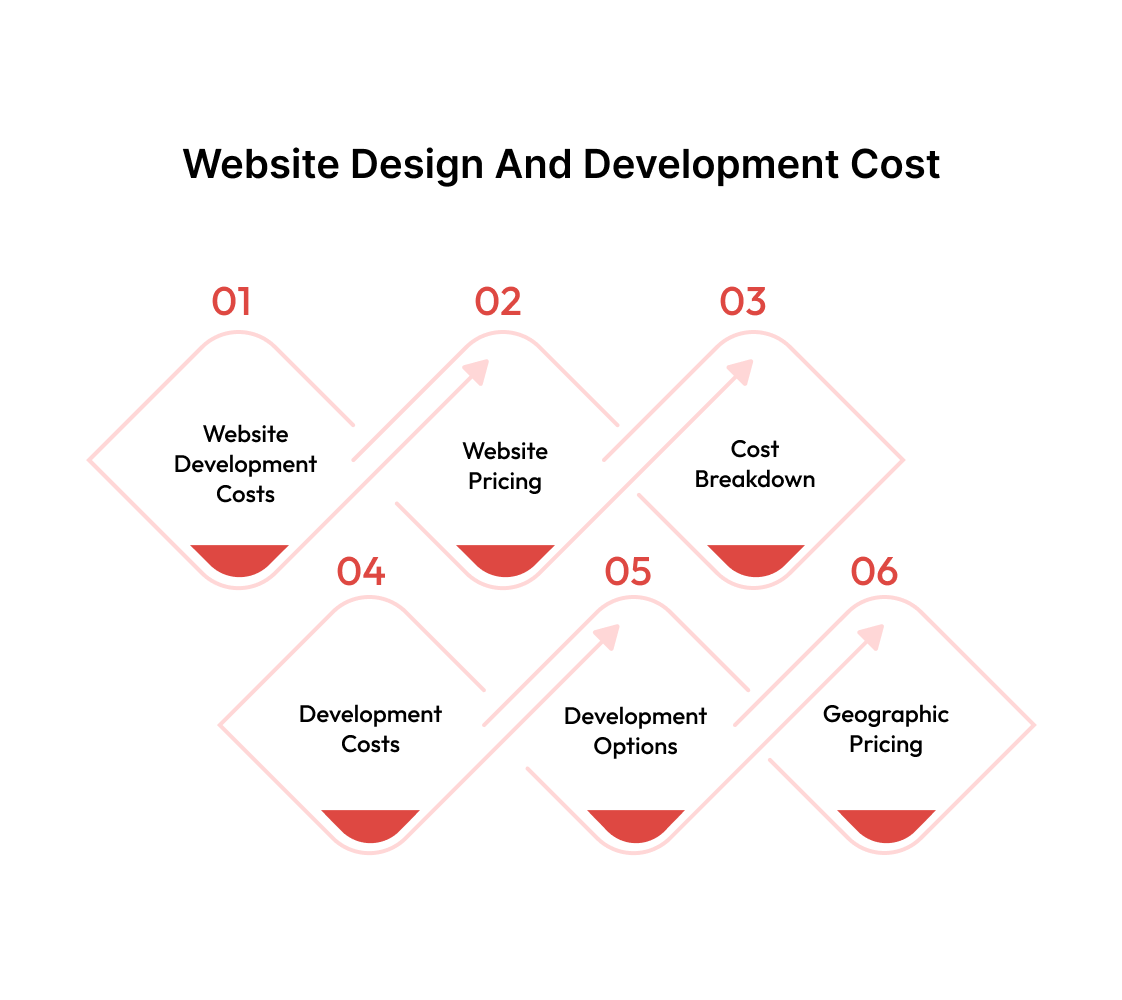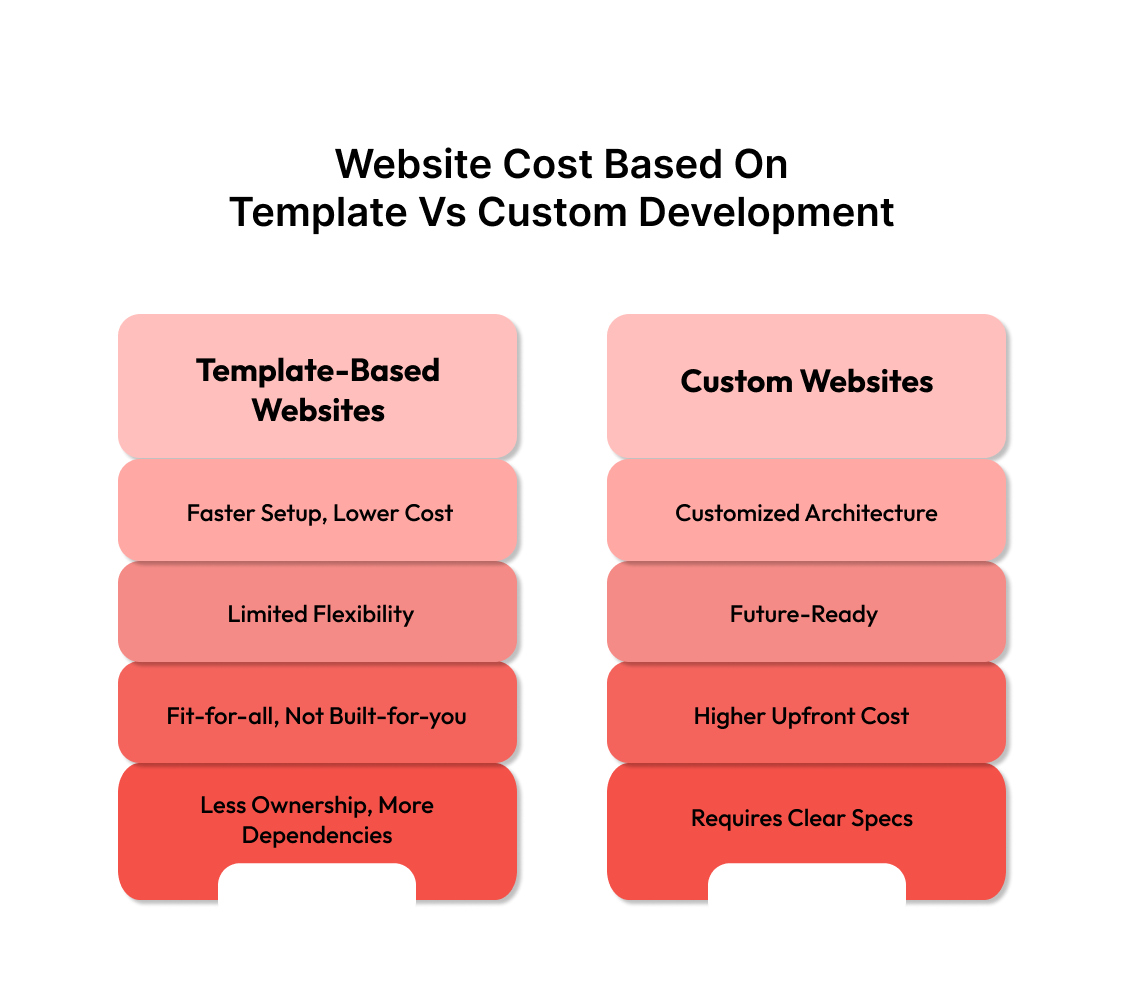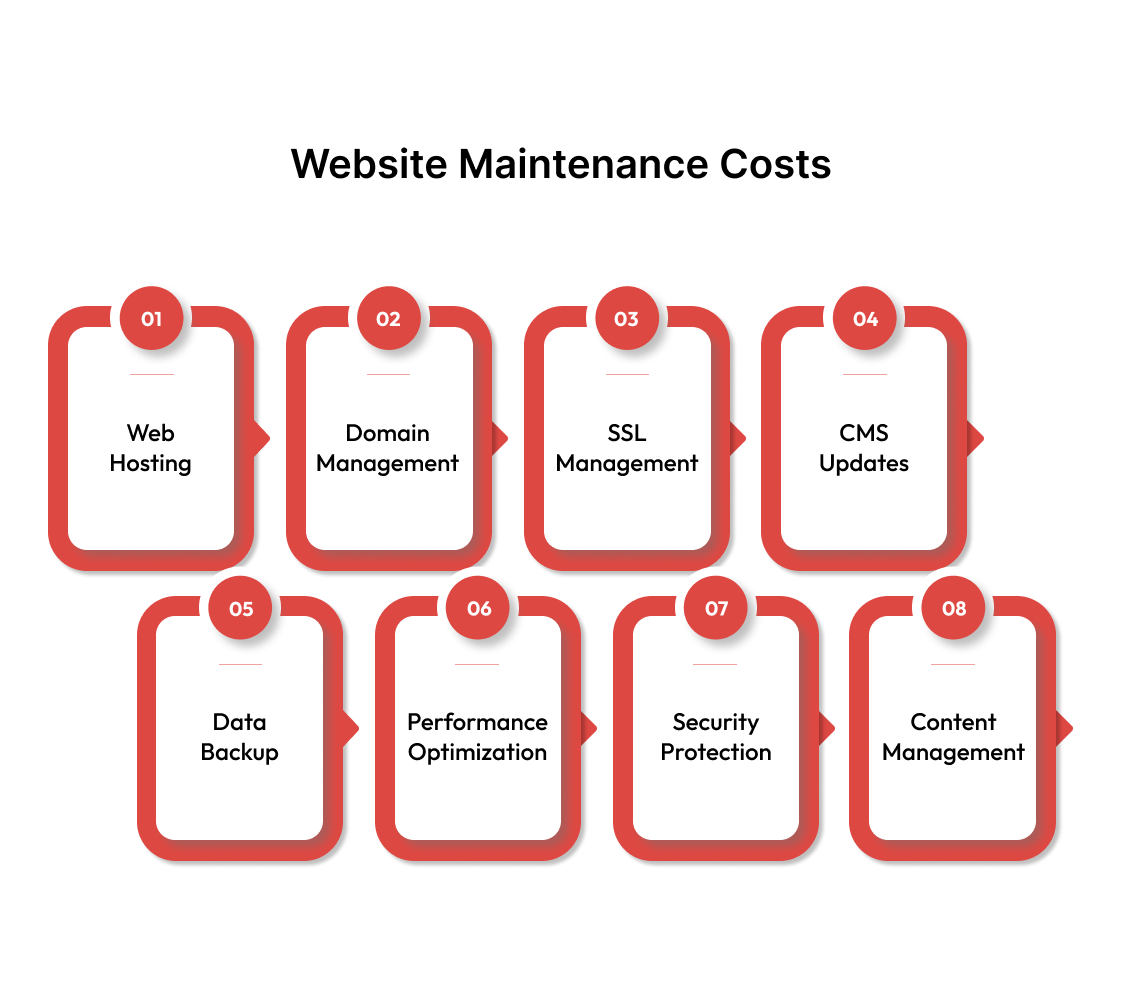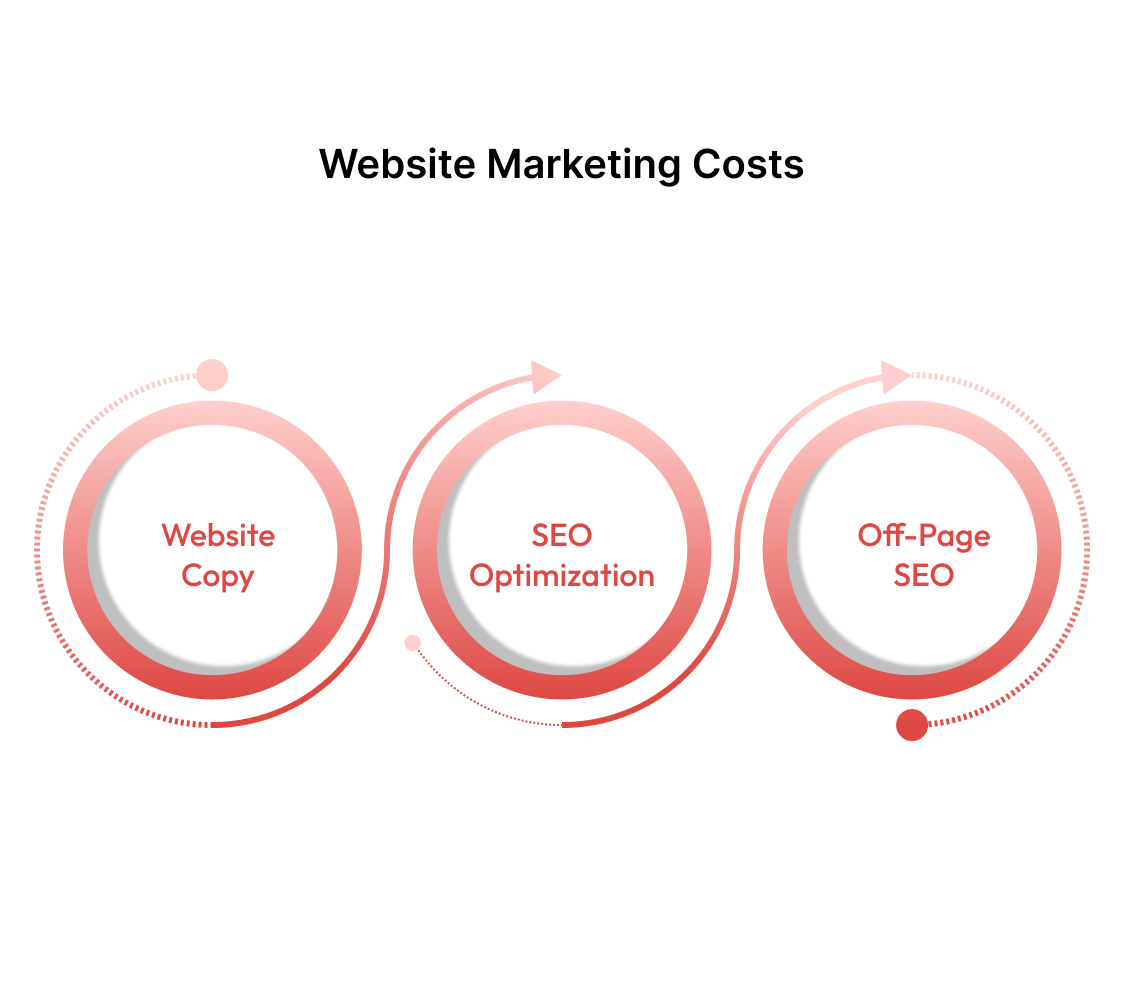TL;DR
- Website development in 2025 typically costs between $3,500 and $35,000 or more.
- The final price depends on your site’s complexity, goals, and the team you hire.
- Ongoing maintenance costs include hosting, updates, security, and third-party tools.
- Marketing requires separate investment in SEO, content, and off-page optimization.
- DIY builders are affordable but offer limited flexibility and scalability.
Every competitor in your space has a dynamic, polished website. Nearly 252,000 new websites launch daily. That's roughly 10,500 every hour. What are your odds of building something that stands apart while driving real conversions?
The answer sounds simple, but proves complex: you need an exceptional website developer. Someone who grasps your business model, knows which conversion tactics work for your audience, and understands what absolutely won't.
Before you pitch stakeholders or hunt for the right web development agency, you need realistic budget expectations.
Anywhere between $3,500- $15,000 represents a solid starting point for a customized, responsive B2B SaaS website. The more complexity (custom integrations, advanced user dashboards, payment gateways, API connections), the costlier your project will be.
However, no universal price exists since multiple factors influence final costs. Let us walk you through each variable so you can make informed decisions.
How Much Does Business Website Development Cost in 2025?
We’ve scoped and delivered dozens of projects in the past year alone, ranging from lean, fast-loading sites for indie SaaS founders to fully custom portals for large-scale organizations.
There’s never one fixed number, and quoting without context almost always backfires. But there are patterns. Based on what we’ve seen, you can start drawing realistic budget lines depending on your goals, expectations, and required features.
The starting cost of building a website in 2025 typically falls within these ranges, depending on what the project demands:
Now, the ballpark figures above give you a starting point, but they don’t explain why costs jump from five figures to beyond. That shift usually happens when function meets complexity - site speed, data handling, integrations, and performance under load.
This is where frontend, backend, and full-stack development start to matter. Each adds weight to the build in different ways. Let’s break it down.
Chapter 1: Website Design and Development Cost

This chapter breaks down the core factors that determine website development pricing, from technical requirements to project complexity. We will explain how different development approaches, website types, and implementation choices directly impact your final investment.
1. Website Cost Based on the Type of Development You Need
In order to accurately estimate the cost of a website, you need to understand which parts fall under frontend, backend, or full-stack development, as this will directly shape the tech stack required for your project.
The tech stack is the key cost driver here. It determines how much work goes into both the visible parts of your site and everything running in the background.
We have summarized what each type of development involves and how it typically affects cost in the table below:
Before you jump into picking a dev team or platform, it’s just as important to look at the type of site you actually need. Not all websites are built the same.
2. Website Cost Based on the Type of Website You Need
The goals, structure, and tech behind a restaurant landing page won’t compare to a SaaS platform with user logins, billing workflows, and integrations. Different levels of complexity bring different design and development demands, and with that, cost.
At the base level, you’ll find template-based websites. These are quick to build, low on customization, and usually meant for a simple online presence.
Next up are template sites with light customizations. Think custom branding or some CMS tweaks. Then come custom-designed websites, often with animations, scroll effects, and unique layouts.
Beyond that, you step into feature-heavy sites, often built for SaaS products or platforms. These usually include dashboards, payment systems, gated content, and advanced backend logic.
Here’s a detailed cost breakdown of websites based on the level of features you want integrated:
Once you’ve figured out the scope and complexity, the next variable is what the site is actually meant to do. Your website's purpose determines which features actually drive business results.
Each website type serves specific goals and audiences, requiring different approaches to design, functionality, and user experience.
3. Website Cost Based on Type and Purpose
A content-heavy blog doesn't cost the same as a conversion-focused eCommerce store or a B2B site with lead scoring and gated assets. The type and purpose of your website drive both the structure and the resources required to build it right.
Some are built to inform. Others are designed to sell. A few do both and more. Here’s how the most common types of websites compare:
A. Blog Website
Content remains the backbone of digital marketing strategy across industries. According to HubSpot, SEO-optimized blogs rank as the top ROI-driving channel for B2B brands, while content marketing ranks third for B2C companies.
Blog websites focus on publishing, organizing, and promoting written content to attract and educate potential customers.
B. Portfolio Website
Designed to showcase work samples, projects, or case studies. Think designers, photographers, writers, and consultants. Clean design and fast load times matter here. Visitors come to scan work, get a feel for style, and reach out, so the build is usually simple but sharp.
C. Corporate Website
This is the typical informational site: who you are, what you do, and how to reach you. Usually includes a homepage, service or product pages, an About section, and a contact form. Good for consultants, agencies, and offline businesses wanting a digital footprint.
D. E-commerce Website
Online retailers need robust product management, secure payment processing, and inventory tracking capabilities. These sites handle transactions, customer accounts, order fulfillment, and often include features like reviews, recommendations, and loyalty programs. Revenue generation happens directly through the platform.
E. SaaS Portals
Software companies require sophisticated user onboarding, product demonstrations, and integration showcases. These sites usually include user dashboards, trial signup flows, pricing comparison tools, and API documentation.
F. Membership Website
Subscription-based businesses and exclusive communities use membership sites to deliver premium content behind login walls. These platforms include user authentication, payment processing, content restriction, and community features. Revenue comes from recurring subscriptions rather than one-time purchases.
G. Landing Page/Microsite
Single-purpose pages designed for specific marketing campaigns or product launches. These stripped-down sites eliminate distractions and focus entirely on one conversion goal, e.g., email signups, product purchases, or demo requests.
Here are ballpark figures to help you gauge how much it’s going to cost to build a website that fits your business type and conversion goals:
Before you lock in a budget, you need to know whether you're going with a template-based setup or a fully custom build.
These two approaches don’t just impact visuals but also affect timelines, scalability, performance, and technical flexibility. The wrong call here usually ends up costing more in the long term.
Here’s how they stack up across key areas:
4. Website Cost Based on Template vs Custom Development

Template and custom development represent two distinct philosophies in web creation. Templates prioritize speed and cost efficiency, while custom builds focus on unique functionality and brand differentiation.
The overview below should help you make the right choice for your business stage and goals.
A. Template-Based Websites
Template sites are built using pre-designed layouts available on platforms like Webflow, Squarespace, or Wix. They’re fast to launch, low on upfront cost, and ideal when you're not expecting to scale aggressively anytime soon.
That said, they’re best for simpler websites without complex logic, integrations, or performance demands.
What It Offers:
✅ Faster Setup, Lower Cost
Templates come pre-built, so you’re mostly slotting in content and colors. Perfect if you’re racing toward a quick launch.
🔧 Limited Flexibility
Good luck bending a template too far. You may hit layout or feature limitations once the business starts growing.
🧩 Fit-for-all, Not Built-for-you
You’re adapting your brand to fit someone else’s structure, not the other way around. It works, but only to a point.
🔄 Less Ownership, More Dependencies
With platforms like Webflow, Squarespace, or Wix, you’re tied to their hosting and functionality limitations.
B. Custom Websites
Custom sites are designed and built from scratch based on your brand, goals, and how users actually move through the site. You get full control over structure, layout, and functionality.
These take more time and cost more upfront. However, they do scale better, convert better, and usually require fewer workarounds later on.
What It Offers:
🛠 Customized Architecture
Everything, right from layout to features, is built around how your business works, not around a generic mold.
🚀 Future-Ready
Custom builds let you scale without starting over. You can add features, tweak UX, or hook into third-party tools without a major rebuild.
💰 Higher Upfront Cost
Custom means more time from designers, developers, and testers. But it also means better conversions and smoother user flow.
⚙️ Requires Clear Specs
The more detail you provide upfront, the more accurate your quote will be. Without that, costs can spiral during the build.
Template vs Custom: Quick Cost Comparison
Once you've mapped out what you need and how custom the build has to be, the next big decision is who’s actually building it. There's no universal right answer as each option comes with trade-offs. It all depends on your budget, your timeline, and how hands-on you want to be.
5. Website Cost Based on DIY vs Agency vs Freelancer
The “who” behind your website development matters as much as the what and how. Your choice between handling development internally, hiring individual freelancers, or partnering with agencies creates vastly different experiences in terms of cost, quality, timeline, and ongoing support.
A. DIY Website Builders
DIY website builders are drag-and-drop tools that let you build a site without writing code. They’re great for small budgets, especially if you're doing everything yourself. But with speed and affordability come trade-offs in control, scalability, and long-term flexibility.
⚡️ Low Cost, Fast Start
Great if you're bootstrapping and need an online presence quickly. Tools like Wix or Squarespace are affordable and intuitive.
🧱 Limited Control
You can build a decent homepage and contact form, but forget complex features or scalable structures.
🧍 You're On Your Own
Design, copy, SEO, testing - it’s all you. It can be challenging if you’re not used to building sites.
However, website design and development aren’t as complicated as they used to be. Today, there are plenty of no-code builders that let you launch fast without touching a single line of code.
That said, you still need to choose the right one based on your goals. For SaaS websites in particular, we recommend Webflow. It offers better scalability, solid hosting, and clean security features. Plus, the design flexibility and intuitive CMS make it a strong choice for growing startups.
The only real cost here is whatever the builder charges for hosting and access. If you're considering this route, feel free to check out our detailed guide on Webflow’s pricing plans to see what fits your budget.
B. Freelance Developers or Designers
Freelancers are a solid middle ground if you need a quality build without paying full agency rates. You get personal attention and flexibility, but at the same time, you also have to choose carefully. Experience, communication, and reliability vary a lot from one freelancer to the next.
💼 Affordable for Smaller Projects
Hiring a skilled freelancer gives you flexibility and personal attention, usually at lower rates than agencies.
🤝 Varies Wildly by Skill
Some freelancers are top-tier. Others ghost mid-project. Vet carefully and check portfolios, not just pricing.
🔄 Less Overhead, More Communication
It’s often easier to move quickly and adjust scope when you're working directly with one person.
C. Web Development Agencies
Agencies offer the most structured and scalable option. You’re hiring a team of strategists, designers, developers, and testers who’ve done this many times before. The process is hands-off for you, but the price tag reflects that full-service model.
🔧 Full-Service Capabilities
Agencies handle strategy, design, development, QA, and sometimes even SEO and content, aka end-to-end service.
🛑 Higher Price Tag
You're paying for a full team and a polished process. But you also get timelines, backups, and formal project management.
📈 Best for Growing or Complex Sites
If your site is tied to revenue or investor reporting, the agency route often saves money in the long run.
Before you lock in on DIY, freelancer, or agency development, you need one more crucial consideration: location. Whether you want to work with developers locally or outsource to offshore teams fundamentally changes your budget equation and project dynamics.
6. Website Cost Based on Location
Top web development agencies in the U.S. bring strong process maturity and industry familiarity.
However, with the rising cost of skilled labor, many businesses are turning to offshore teams in regions like India, Eastern Europe, or Southeast Asia, where you’ll find high-quality work at more affordable rates.
The table below depicts how geographic location impacts hourly rates and total project costs across different skill levels.
That wraps up the core cost breakdown for design and development. Whether you're building something lean or commissioning a full-scale custom site, knowing where your money goes helps avoid surprises down the line.
However, design and development are just the starting line.
All websites, regardless of their scale or purpose, require ongoing maintenance. And the cost of keeping a site live, secure, and performing well adds up faster than most people expect.
Chapter 2: Website Maintenance Costs

Websites don’t just run themselves. They rely on hosting servers, storage, third-party tools, and regular upkeep to stay fast, functional, and secure. These background services make sure your users get the experience you planned, without slowdowns, errors, or security issues.
Maintenance requirements directly impact your bottom line since poorly maintained websites lose visitors and conversions fast. Research shows that every additional second of page load time decreases conversion rates by approximately 2.11%.
Intimidating statistics aside, here are the essential maintenance components and how they impact your annual budget:
- Web Hosting Services: Server space, bandwidth, and uptime monitoring keep your site accessible 24/7. Shared hosting works for basic sites while dedicated servers handle high-traffic demands.
Estimated annual cost: $100 - $2,400.
- Domain Registration and Renewal: Your website address requires annual renewal, plus potential premium domain fees for competitive keywords or branded extensions.
Estimated annual cost: $15 - $500
- SSL Certificate Management: Security certificates encrypt data transmission and boost search rankings. Basic certificates cost less, while extended validation certificates provide maximum trust signals.
Estimated annual cost: $50 - $300
- Content Management System Updates: WordPress, Drupal, and other CMS platforms require regular core updates, plugin maintenance, and security patches to prevent vulnerabilities.
Estimated annual cost: $500 - $2,000
- Backup and Recovery Services: Automated daily backups protect against data loss from server failures, hacking attempts, or human error during updates.
Estimated annual cost: $200 - $1,200
- Performance Monitoring and Optimization: Speed testing, uptime monitoring, and performance optimization ensure fast loading times and smooth user experiences across devices.
Estimated annual cost: $300 - $1,800
- Security Monitoring and Malware Protection: Active threat detection, firewall management, and malware scanning prevent costly security breaches and reputation damage.
Estimated annual cost: $400 - $2,500
- Content Updates and Modifications: Regular blog posts, product updates, pricing changes, and seasonal content refreshes keep your site current and engaging.
Estimated annual cost: $1,200 - $6,000
Building and maintaining a website gets you to the starting line, but traffic and conversions don’t just appear on their own. If your site is part of a larger business strategy, you need to smartly invest in website marketing as well.
Chapter 3: Website Marketing Costs

This guide would be incomplete without addressing the marketing investments needed to make your website profitable. These costs solely apply to businesses that want their website to actively generate leads, sales, and brand awareness rather than simply exist as a digital placeholder.
Website marketing spans an enormous territory, making precise cost estimates challenging without knowing your industry, competition, and growth goals.
This topic deserves its own comprehensive article (actually, great idea for our next piece!). However, we can break marketing investments into three core categories that drive the majority of website success.
1. Website Content and Copywriting
This includes homepage messaging, service page copy, blog articles, product descriptions, landing pages, case studies, and lead magnets.
Quality content creation requires significant investment in research, writing, editing, and optimization. Most businesses spend $2,000-$8,000 monthly on professional content creation through in-house writers, freelancers, or content agencies.
Higher-end industries like finance or healthcare may invest $10,000+ monthly due to expertise requirements and compliance considerations.
Where you’ll spend:
- Copywriting for core pages
- Blog strategy and content
- Visual content like infographics or product visuals
- SEO-focused content audits or rewrites
Typical cost range: $2,500 – $10,000+/year
2. Search Engine Optimization
Search engine optimization helps your website appear when potential customers search for problems you solve. It blends technical tweaks, keyword strategy, competitor research, and content planning to push your pages higher in Google results.
SEO is an ongoing process that shapes how your site performs long-term. Small businesses typically invest $800–$2,000/month for local and core keyword visibility. Full-service SEO campaigns can range from $1,500–$5,000/month.
In high-stakes markets, enterprise SEO can top $10,000/month due to the depth of content and link building required.
Where you’ll spend:
- Keyword and competitor analysis
- Technical SEO audits and fixes (Schema markup and technical fixes, mobile UX optimization, etc.)
- On-page SEO (titles, meta tags, internal linking)
- Structured data and crawl optimization
- Reporting and performance tracking
Typical cost range: $800 – $5,000/month
3. Backlink Building and Off-Page SEO
If content tells Google what your site is about, backlinks tell Google it’s worth listening to.
Link building includes outreach, guest posting, digital PR, and buying placements - all of which require serious time or outsourcing.
Where you’ll spend:
- Guest post outreach and writing
- PR or link placement services
- Directory submissions or citation building
Typical cost range: $2,000 – $20,000+/year
By now, you should have a clear picture of what goes into building, running, and marketing a website in 2025.
That said, all the figures above should be taken with a generous pinch of salt. No article can give you a precise estimate without understanding your actual goals, technical needs, and growth plans.
A qualified web designer or agency should be able to walk you through realistic pricing based on your brief without hiding surprises in the fine print. You’ve likely found the right team when they’re upfront about which extras might add up as the project evolves.
Jumpstart Website Design & Development Journey With Beetle Beetle
If you're looking for a website design house that offers end-to-end website creation services, Beetle Beetle is the right choice for you. From market and competitor research to design and website copy creation, we do it all.
We're a US-based B2B SaaS website development and revamp studio, laser-focused on driving conversions and revenue growth. We work with only two companies per month due to our comprehensive approach and attention to detail. Only 3 in 10 companies we evaluate make the cut for partnership.
You'll be an ideal fit if you have:
- A high-quality product that customers genuinely love and recommend
- Monthly recurring revenue exceeding $30,000 or secured funding for growth
- Average revenue per user of at least $100 monthly or $12,000 annually
- A B2B audience actively seeking solutions to real business problems
- Strong ambition to scale and dominate your market category
- Commitment to invest time in the process and execute properly
Our packages start at $15,000 for basic builds, $25,000 for professional implementations, and $35,000+ for enterprise solutions. You can customize packages to match your specific requirements and growth objectives.
For detailed information about our process and a complimentary project estimate, book a discovery call today.
FAQs
1. How much should I pay for website development?
That depends on the scope, team, and features. Basic websites start around $3,500. Custom, full-stack builds with integrations can go beyond $35,000.
2. How much will it take to build a website?
If you’re using a DIY builder like Webflow or Wix, expect to spend $0–$34/month for tools, plus your time for content, design, and setup.
3. How much should a 20-page website cost?
For a professionally built 20-page site, expect a starting price of around $12,000–$18,000, depending on design complexity and functionality.
4. How much does a 50-page website cost?
A 50-page site often involves layered navigation, content strategy, and CMS setup. Costs typically range between $25,000–$60,000 or more.
5. What is the cheapest website builder?
Wix, Weebly, and Carrd offer free starter plans. But for better scalability and control, Webflow’s $19–$34/month plans offer better long-term value.
































